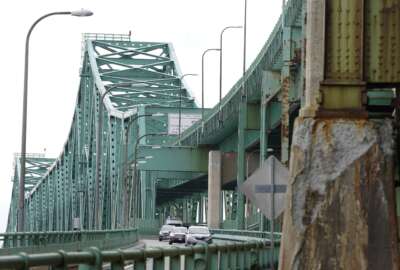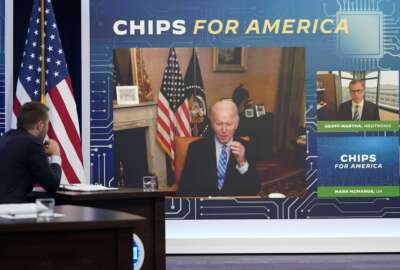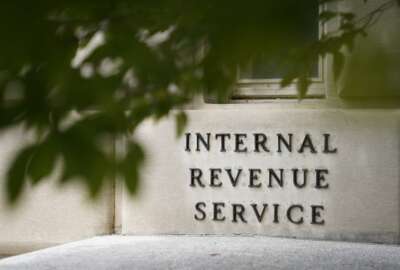Hubbard Radio Washington DC, LLC. All rights reserved. This website is not intended for users located within the European Economic Area.
On Air: Federal News Network
Trending:
A new way to keep track of all that Inflation Reduction and CHIPS Act money
With the passage of the Inflation Reduction Act, the CHIPS and Science Act, and the Infrastructure Investment and Jobs Act, that means a large amount of investm...
With the passage of the Inflation Reduction Act, the CHIPS and Science Act, and the Infrastructure Investment and Jobs Act, that means a large amount of investment from both the private and public sector. With much of it going to local infrastructure and manufacturing endeavors, it can be tough for people, especially private citizens, to find out where that money is going. To help, the Center for American Progress has created a new tool to catalog more than 35,000 of these investments. To find out what went into this project, Federal Drive with Tom Temin spoke with Emily Gee, who is senior vice president for Inclusive Growth at American Progress.
Interview Transcript:
Emily Gee There’s a historic changes going on in America right now in a few different areas that will grow the economy and help grow the middle class. These are changes happening in manufacturing, in American competitiveness and investing in workers and in accelerating our transition to a green economy. These were made possible by a few really big pieces of legislation that passed in the first couple of years of the Biden administration. And on the ground, these are happening through literally tens of thousands of investments, both with public money and from the private sector to revitalize manufacturing for the economy. And so we want to catalog what’s happening all across America.
Eric White Got it. And what went into this? What sources did you have to pull from to get both the public and private sector investment information? Where did you all find that?
Emily Gee So the tracker has individual level records which will give you, say, for example, a battery plant in a certain state and tell you how many jobs it’s created. Some of this information is readily available through government resources, including build.gov and USASpending.gov. So there is really good infrastructure there for the federal awards that are being made through the Information Reduction Act, the CHIPS and Science Act, and also the Infrastructure Investment Jobs Act. The part and this is credit to my colleagues here at Center for American Progress and the harder part has been scouring news clips and the Internet and company press releases to gather all this information about private investment, which when we started this project, there was no central source for. So it’s a big research project. We think it’s really investment because public investment tells only part of the story what’s happening. These laws have been enabling and crowding in private money from companies to upskill workers and and grow our manufacturing base and make more things here at home.
Eric White And is there any attempt to take maybe a deeper look at like you just mentioned, the kinds of jobs that are being that are being created from these investments. Nothing against the Biden administration. But sometimes the job numbers can be low. Everybody rounds up, right?
Emily Gee Absolutely. And one thing that we believe here at CAP is that what’s important about this economic transformation is not just what we’re making or how big it is, but how we’re implementing it, the fact that we’re making good jobs, that we’re using American made steel, the domestic content requirements for renewable energy inputs. And that we are we need to be creating union jobs that are good paying and the kind of jobs and for raising a middle class family on. So one unique feature of our tracker is that in addition to having those basics like job numbers or dollars or the location is we have an indicator, if we have confirmed that the job is the manufacturing plant or construction project is union. And we also have trying to connect these sort of abstract records to what it really means for people. So if you pull up in any given record, you’ll see links to news clips and other information from local press about what these investments will mean for their community.
Eric White Yeah. And one of the categories is you can narrow it down to congressional district. I foresee that maybe you all are or are seeing the writing on the wall for the 2024 upcoming elections.
Emily Gee Oh, I think we’re already seeing it. We’ve we’ve got these projects are going in all over America. Every state, doesn’t matter red states, blue states. And there you can pull up a district and see what’s happening. And we are seeing members of Congress who voted against some of these bills coming out and cheering these projects as shovels go into the ground because they know that this is job creation and this is economic revitalization of cities and towns across America.
Eric White Emily Gee is senior vice president of Inclusive Growth at the Center for American Progress. And so who are the intended users of this? Obviously, you’d probably like to see some more political involvement from voters themselves, but is there a business aspect to this? Could folks maybe see where investment dollars are going in certain areas or in certain industries.
Emily Gee The tool is public, so anybody can go to our our website, Americanprogress.org and check out the tracker search by all sorts of things keyword, program, location. So we are again, it’s anybody but I think our sort of our main the main targets that we had in mind were members of the press. And whether you’re a national reporter or a local podcaster, regional newspaper, you can go there and pull up what’s happening in your community or your region to get a bigger picture of across things like water and construction and semiconductors, what the result of this economic agenda is doing. Another audience is community groups who might want to know what’s happening, including can be where opportunities to put pressure on government at any level or private sector entities to make sure that we’re doing this in a way that’s pro-worker, that’s pro-environment, and that has a has, I think will have the maximum benefit for a community, whether that’s building pedestrian friendly roads or prioritizing high-need areas with cleaner water or cleaner air. And then lastly we do have the policymakers will use it too, to find out how other mayors or other governors might be might be using their money through the infrastructure bill, say. And I think I think it will also enable, say, members of Congress and their staff and elected leaders to hold up what’s happening in their district or their state to see what’s changing and what’s happening where things are in the process.
Eric White What can you tell me about the team that was involved in putting this together? Who were they and how many people were there? And are there people watching it to keep it updated? And as more investment money comes in?
Emily Gee This was a huge team effort with so much talent across across our organization. We are a multi issue think tank and we are covering policy issues spanning from environment and the economy and infrastructure too, but also people with expertise in communications and digital media. And so this is a project that embodies all the talent that we have across our organization. I will say I’ll give a special shout out to my colleague Will Ragland, who spearheaded this and made sure that we are vetting projects for for whether they are union or not, for making sure that it pulls up the information you want and anticipating how this could be useful to others and anticipating jobs and making sure that we have the information that was most useful to people.
Eric White Where does the amount of investment dollars stand in the, I don’t know how necessarily how long you all have been looking at this, but from a historical standpoint, are we at a coming out of the pandemic, obviously, some money was going to be needed to get people back working and the economy grinding again. Where does this time period stand as compared to other periods?
Emily Gee So this is truly of historic proportions. I mean, the I think the public money alone is over over a trillion, but that doesn’t count the changes in the nature of producing or how we’re doing it. And the money that’s been dedicated about it by the private sector. I mean, one example that sticks out because we wrote about it recently, as in Michigan Ford announced a 3.5 billion commitment to build a battery park in Marshall, Michigan, that will provide batteries for the next generation of electric vehicles. To give you an idea of the scale, it’s just 60,000 and counting records that we have in our tracker across public and private, and that’s increasing on a on a regular basis. This is altogether this investment agenda represents a industrial strategy on the scale and scope of the interstate highway system that went up in the middle of the last century.
Copyright © 2024 Federal News Network. All rights reserved. This website is not intended for users located within the European Economic Area.
Tom Temin
Tom Temin is host of the Federal Drive and has been providing insight on federal technology and management issues for more than 30 years.
Follow @tteminWFED
Related Stories
‘Unlike…any other program’: Commerce IG prepares to oversee $50B CHIPS Act
IRS could have trouble spending billions of Inflation Reduction Act dollars on new employees
Related Stories
-
The Federal Permitting Council gets a new lease on life thanks to new infrastructure spending Facilities/Construction





